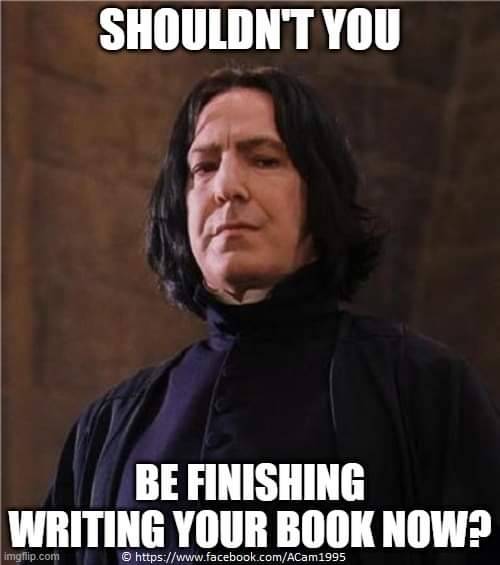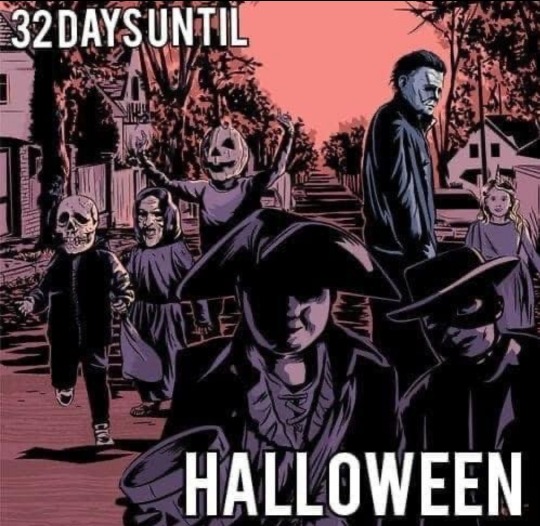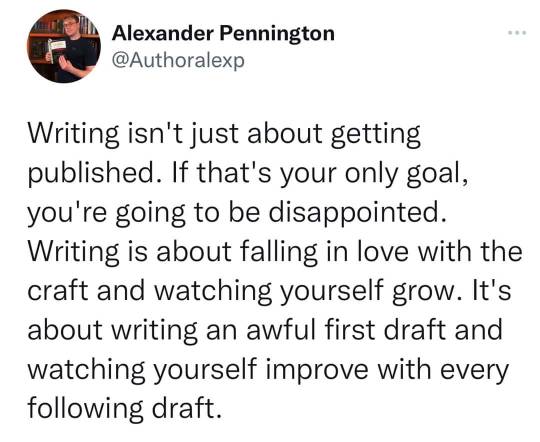Text

Here's a snippet of what's to come! Enjoy the introduction to "Workaholic," which can be ordered from Something Or Other Publishing @ https://soopllc.com/product/Workaholic/
My father was a workaholic. The old man had slaved his days away in the coal mines—proud to be doing his part to fuel Appalachia, but a stranger at the dinner table where my mother always kept a plate ready. They taught me as a child that hard, dedicated work was the path of righteousness, something to aspire to. Be devoted to your employers, and they’ll be loyal to you. Earn your keep and they will reward you. In the end, all I earned was an empty pill bottle and this lousy pickaxe.
The blade was dull when I pulled it from the dark closet, stained with years of rust from neglect. A physical symbol of my labor’s burden, the tool dragged after me, scraping against the rough tile floor of the office where I used to work. Admittedly, I was no longer sure whether the wake of red flakes left behind was corrosion or blood. Despite the bright, shining lights and the bitter silence, I could no longer distinguish between what was real and what wasn’t. My former coworkers cowered under their desks while I shuffled. Quiet, as they had been when they all saw me drowning, and praying to the God that forsook us when I passed. One of the faceless screamed when the tip of the ax crashed through the wall of her cubicle. Removing it decapitated the kitschy kitten poster that bolstered everyone to “hang in there.”
I did hang in there. I had gripped the edge of sanity with my fingernails.
#horrorauthor#thriller#horrorpaperbacks#horroraddict#horrorwriter#b#kindle#bookreview#shorror#paperback#horrorreads#paperbacksfromhell#horrorgeek#horrorlife#booklove#horrorstory#constantreader#horrorliterature#horrorfamily#reader#horrorreader#thrillerbooks#horrorjunkie
9 notes
·
View notes
Video
youtube
Winners: A Compilation of Award-Winning Short Stories | Official Book Tr...
Start your 2023 TBR list off right with “Winners”!
This collection of award-winning short stories features something for everyone - love, excitement, and spiritual connection. No matter your taste, “Winners” promises delight. Get your copy today!
https://soopllc.com/product/Workaholic/
#horror author#horroraddict#readers#readers of tumblr#book review#horrorreaders#horrorgeek#horrorlife#booklover#horror stories#constantreader#horror literature#horrorfamily#bookblr#horrorreader#thrillerbooks#horrorjunkie
0 notes
Text
Definitely a dreamer here. Sometimes I spend more time in my own world than the real one.

0 notes
Text
Starting Strong Scenes in Your Writing
Scenes are the fundamental building blocks of novels and short stories, and each one should propel a story toward the climax.
Generally speaking, your scene structure should mirror the story structure. In other words, take a novel-writing approach to a scene, crafting a beginning, middle, and end. Like a story, the beginning of a scene should have a strong entry hook that pulls the reader in.
Start with the setting. Often a new scene signifies a change in time and location. Establishing the setting at the top of a scene helps your readers get oriented. It also sets the tone and mood of what will unfold in the coming pages. A setting can serve as much more than a backdrop in literature. Have your scene take place somewhere that builds tension and hinders your protagonist. If you’re writing a thriller, describe a dark and foreboding place where the worst might happen. Be descriptive and use sensory details to make your setting come alive before you jump into the action.
Use visual imagery. In screenwriting, writers have to think in pictures. What images will excite an audience at the top of a scene? Your approach should be the same when writing any kind of fiction. As you write the opening of a scene, use descriptive language to engage a reader through detailed imagery. Think like a screenwriter as you’re writing scenes.
Drop the reader into the middle of the action. Hit the ground running by starting a great scene in media res. It doesn’t have to be a fight scene or a car chase, but physical movement creates momentum and builds tension in a story. It’s also a way to instantly engage a reader. Be sure you begin the scene before the high points of the action so you build up to the scene’s climax.
Write a character-driven scene opener. A good scene starts by giving characters a goal. Start by putting your protagonist in a situation that creates an obstacle or opportunity for both the scene and the overarching storyline. Try starting with dialogue, like an intense conversation between your POV character and a mystery character whose identity is revealed later in the scene. If you’re writing from an omniscient third-person point of view, consider starting a scene with a secondary character, even the antagonist, and use it as a chance for deeper character development.
Summarize past events. You might choose to use the beginning of the scene to do a quick recap of what’s brought your main character to this place and moment in time. A summary is especially helpful if you’re writing in third-person and a new scene switches to a different character. Take the opportunity to remind the reader where we left off. Instead of a straight-forward update, get creative. Go into deep POV and let a character’s thoughts provide the summary instead of the narrator. Be sure to keep this summary brief—just a line or two—so you can get back into the action.
Introduce a plot twist. The start of a new scene is a chance to pivot and take your story in a new direction. Start a new scene at a turning point in your story. Dive into a flashback or character’s backstory, revealing critical information that changes the course of the story going forward.
Keep the purpose of the scene in mind. Effective scenes are clear about what they set out to accomplish and how they contribute to the overall plot. They might include plot points or reveal important information needed to move a story forward. Establish your scene’s intention from the very first word and keep the rest of the scene on point.
Rewrite until you’ve found the perfect scene opening. When you’ve finished the first draft of a scene, go back and read it through. If your scene needs something, but you can’t figure out what, it might be how the scene starts. The best way to know if your opening works is by reading how it plays with the rest of the scene. Review the last paragraph and see if it ties back to your beginning. If the intro feels weak, rewrite it. Maybe your real opener is hidden in plain sight somewhere else in the body of the scene.
Make sure your opening scene is your strongest. While your entire book should be filled with compelling scenes that start strong, the very first scene of your book needs to lead the pack. This is the reader’s introduction to your story and where you’re revealing the characters, the setting, and kicking off the plotline with the inciting incident. This first scene has to hook the reader from the first line so they keep turning the pages.
Read a lot of books. If this is your first novel and you need some inspiration and ideas to help you start off your scenes, start by reading other books. Choose a book by a bestselling writer like Dan Brown or Margaret Atwood. Study the different ways they approach every scene. Reading other authors is a great way to hone your scene-writing skills.
Follow like and reblog if you find these helpful!
6K notes
·
View notes
Text
Symbols and Their Uses


Motifs and symbols are literary devices that authors have used throughout the centuries. In fact, both motifs and symbols are used in all artistic media: painters, sculptors, playwrights, and musicians all use motifs and use symbols in the most advanced forms of their respective artforms. And while they are similar literary terms, “motif” and “symbol” are not synonyms. There are distinct differences between the definition of symbol and the definition of motif, and they serve somewhat different functions in literature.
Examples and Forms of Symbols throughout history:
1. The earliest recorded forms of human storytelling—cave paintings and hieroglyphics—are quite literally symbols representing more complex narratives or beliefs.
2. Ancient Greek theater, which is the basis for much of today’s narrative artforms, used symbolic props including phallic objects to represent Dionysus, the god of fertility. Symbolism remained in wide use throughout the Middle Ages (almost always with religious connotations) and then, from the Renaissance onward, returned in full force to represent human desires ranging from lust to ambition to heartbreak.
3. William Shakespeare used symbols to represent inner conscience (think of blood in Macbeth or family names in Romeo and Juliet) and William Blake used religious symbols (including Jesus himself) to represent human emotion and desire (as in “The Everlasting Gospel”).
4. Fairy tales frequently contain literary symbolism to convey a story’s central idea to young audiences. The Brothers Grimm frequently used the forest as a symbol of both mystery and peril, as in this passage from Hansel and Gretel, where the children continue deeper into the woods.
Hope it was helpful! Like, share and follow for more!
157 notes
·
View notes
Text
Blurbing;
How to relay a story with minimal headache*
*Minimal headache is still some headache. You’re trying to summarize something that needs thousands of words to properly convey. It’s not going to be easy.
Blurbs are an absolute necessity for marketing your book, and the sooner you have a good one, the easier it is to get people interested in your work. Unless you’re writing a short story, you’ll never be able to include all the interesting parts of your book into a single blurb. That’s okay. The point of the blurb is to pick out the key focus of the story as a whole, and relay that in the most interesting way possible.
When writing blurbs, it’s good to end up with one short/mini blurb, or logline, which should be a single sentence, and one longer blurb which should be a few paragraphs. (Note that a synopsis for a query letter is quite different from a blurb. There are links at the bottom of the post which will help you with a query-worthy synopsis.)
Tips and tricks:
Know what your story is about. No brainer, right? Keep in mind that this isn’t the same as having a summary or outline. You want to know the focus of your story, the thing that remains when you strip everything else away.
Use a formulaic starting point. A good formula to start with looks something like this: “When [INCITING INCIDENT OCCURS], a [SPECIFIC PROTAGONIST] must [OBJECTIVE], or else [STAKES].” Just remember this isn’t a cheat. You’ll still need to rework the resulting sentence.
Start small and expand, or start large and cut out. Figure out a solid short blurb and then turn every key aspect (the protagonist, the inciting event, the objective, and the stakes) into a sentence or two of it’s own, or write the full blurb first and cut away words until you have a single sentence.
Write many versions. Without any rereading, try speed writing 25 short blurbs and 5 long blurbs. Come back when you’re done and pick out the points you feel worked the best and were most true to your story.
Get feedback. Throw your favorite few blurbs at people you trust who are also part of your target audience. Which ones create the most interested in the story itself?
Good explanations on how to write loglines, blurbs, and synopsis, from non-tumblr websites who’s links shouldn’t die:
On short blurbs (loglines)- | One | Two | Three | Four |
On long (back of book) blurbs - | One | Two | Three | Four |
On query-worthy synopsis- | One | Two | Three |
Edit from 2/23/18:
Since I just spent some time reading a bunch of sci fi and fantasy blurbs in preparation for writing Pearl’s, I thought I might update this.
There is no right way to write a blurb. Some are a single paragraph, some are a full page. Some have quotes from the book, some directly mention the author, some focus just on the plot or dedicate most of their space to the worldbuilding. It doesn’t matter what your blurb looks like as long as it sounds good and gets people interested in your book!
A nice, simple format I’ve found to work really well for Speculative Fiction looks something like this:
Part one — The world. Give a strong sense of your worldbuilding and the set up for any political, magical, or technological building blocks important to your plot. This can double as a protagonist (or antagonist!) introduction, or you can leave that for the second paragraph, depending on what flows best.
Part two — The inciting event. What happens to get the story rolling? This should be something within your first few chapters, which sets your protagonist on their path. (If it’s not, you may have some structural edits to do for your novel.)
Part three — The hook. Leave the reader questioning what’s to come! Focus on the disaster the plot is heading for, or point out a game changer or upcoming obstacle.
As mentioned above, this is certainly not the only way to write blurbs. Some novels downright can’t follow this exact structure for one reason or another. Most don’t need to. But it’s still a nice, fairly headache-less exercise to try out when working on a blurb, and it might give you something worthwhile once you’re finished.
4K notes
·
View notes
Text

1 note
·
View note
Text
argument subtext hack
Subtext gets a lot of people tripped up, myself included. It gets especially tricky with arguments. How do these characters fight without directly addressing the problem? What are they trying to say beneath the actual dialogue?
This hack isn't foolproof but it helps me kickstart the thought process of writing around the problem in an argument.

Take the problem that's really the issue here.
For this, we'll say Character A is a compulsive shopper and Character B is their partner, whom they share a bank account with.
Now, how do they fight about A spending too much money without ever bringing up money?
What is Another Example of Character A's Problem That Does Not Name The Specific Problem?
Every problem a character has comes with traits associated with it. Compulsive spending is associated with obsession, impulse issues, love of excess, etc. Pick one and have Character B make an argument about Character A having one of those traits outside of the shopping.
ex. I see you as impulsive because of your spending, so now I'm going to fight with you about showing up to my work to surprise me. It doesn't matter if you thought it was nice, I see it as your need to do whatever you want to as soon as you think of it.
What Does Character B Blame the Problem On?
Right or wrong, the character who instigates the argument has their theory on why the problem with Character A exists. Let them make the entire argument about that.
ex. You must overspend money because you were brought up rich, let's argue about how you look down on me as a blue-collar worker.
OR: You must overspend money because you feel like there's a void in your life, let's argue about how you don't love me enough.
While it's very obvious to us the argument is all about Character A coming home with shopping bags, that never has to be directly said. Depending on how perceptive Character A is, they may never figure out what Character B is really getting after.

Remember, subtext is often about the character being wrong about what the real issue is or not being aware of what's really bothering them.
There's no therapist there to pick out what the root of the issue is.
As always, take what makes sense and leave the rest. Happy writing!
[call it good] writing
390 notes
·
View notes
Text
Writing Lesson XI:
How to actually start writing.
Write a sentence.
Seriously, go write a sentence! It doesn't have to be good, but you need to start somewhere. Block the world out and write it!
You have a sentence now? Okay go write another. And another. And another
Now you got a paragraph, a collection of things?
Good, write another one. Write until you are sick of it and the sky has lost all light.
Write thirty paragraphs, some long and some very short.
Now you have a scene, at least once you give it an ending, be it sad or happy.
You have another scene in you? Write it!
Set up your story, introduce your characters, and then you are well on your way to having a first act!
Oh, your on the second act now?
Mash those pieces you put in place together! Character against self, character against character. Rip them apart and put them back together again!
And when your characters come out alive or dead, move toward the finish line, the final encounters, the finale!
And then wake up and do it again, even if it is a single sentence. 365 days is 365 sentences closer to finishing your story!
Now, go and do it!
737 notes
·
View notes
Text
adding characterization to a story you've already written

How? + What?
These are the questions to take with you when going through a draft to add characterization.
Your character will already be doing and saying things in a set situation. You got the most arduous part of writing down-- the story is there.
So now you're going to take that and ask WHAT? or HOW? with certain details. An interrogation of the story to dig more out when a scene might feel empty or the characterization feels off.
Let's say you want a scene where the character cries in a car.
Anyone can cry in a car.
But only YOUR character is going to cry in the parking lot of their old high school, so angry about their '96 Toyota's heater being broken that they slam their fist against the vents.
HOW? is about defining present behavior.
Take the situation your character is put in.
How do they react, how do they make decisions, how do they set and complete goals, how do they approach emerging emotions, how do they think about or observe the situation?
How do they deal with something like this based on personality, values, and their current life?
All of these things are informed by larger, earlier forces but "how?" is about the state of things that fluctuate.
With the car, present behavior is their anger at the broken heater and the decision to physically lash out. The fluctuation of personality, values, and current life converge in a way that is unique to this moment and this reaction.
WHAT? is about specificity with already-established reality.
Look at every variable in the scene, like the car or the location. They are established. The character had the car before the passage began. This was their old high school before the passage began. Making these variables specific tells us about the character's world outside this scene. What car? What significance of the location? Those are exclusive to the character and existed before the scene. At this point, they are out of the control of the character and therefore do not fluctuate.
An old Toyota with a broken heater and the parking lot of their former high school give us background information.
The main idea of this technique is to push yourself as a writer. Specificity, definition, and characterization enrich the narrative and add authentic complexity to your world.

As always, take what you found useful and forget the rest! Happy writing.
[call it good] writing
1K notes
·
View notes
Text
If your plot feels flat, STUDY it! Your story might be lacking...
Stakes - What would happen if the protagonist failed? Would it really be such a bad thing if it happened?
Thematic relevance - Do the events of the story speak to a greater emotional or moral message? Is the conflict resolved in a way that befits the theme?
Urgency - How much time does the protagonist have to complete their goal? Are there multiple factors complicating the situation?
Drive - What motivates the protagonist? Are they an active player in the story, or are they repeatedly getting pushed around by external forces? Could you swap them out for a different character with no impact on the plot? On the flip side, do the other characters have sensible motivations of their own?
Yield - Is there foreshadowing? Do the protagonist's choices have unforeseen consequences down the road? Do they use knowledge or clues from the beginning, to help them in the end? Do they learn things about the other characters that weren't immediately obvious?
86K notes
·
View notes





